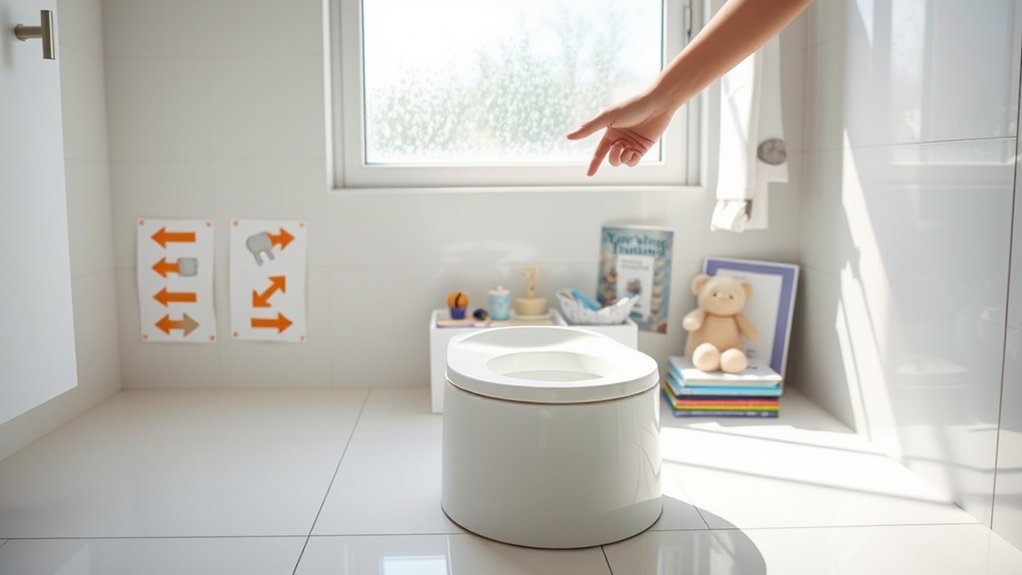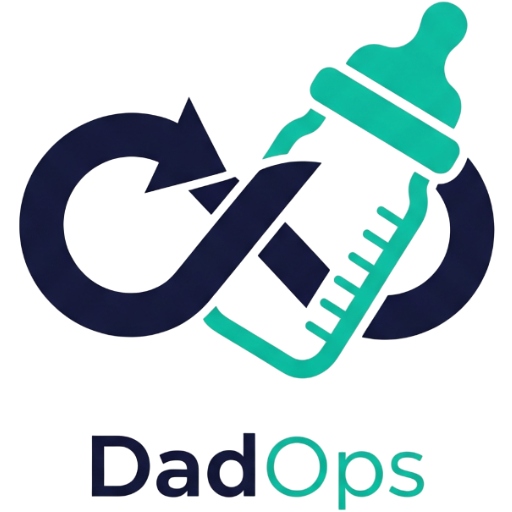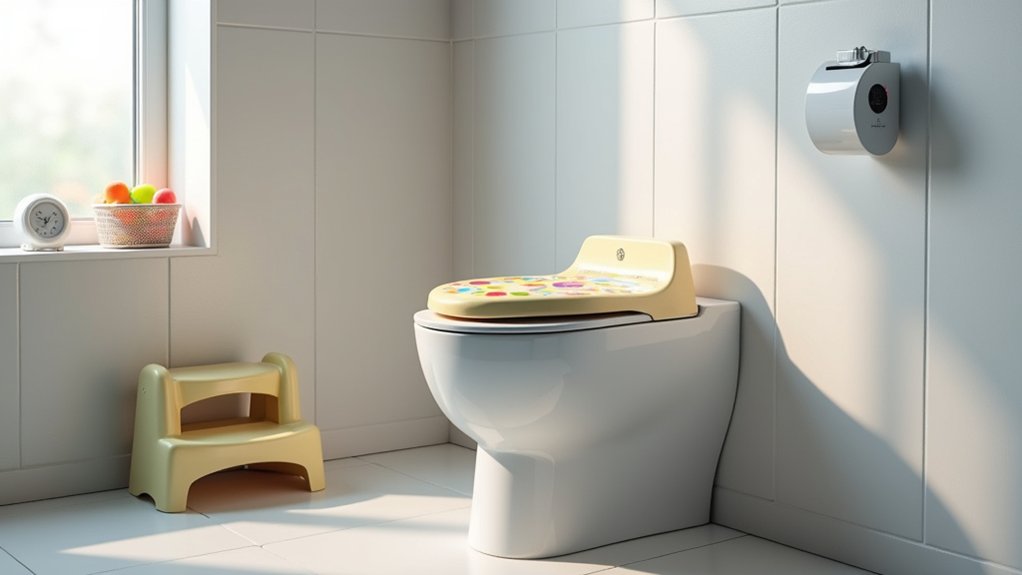You’re about to upgrade your toddler’s system with a playful potty training protocol. Watch for readiness signs—interest in bathroom habits and ability to follow instructions. Set up the ideal environment with a comfy potty chair and non-toxic materials. Keep commands simple like “Time to go potty!” and celebrate victories with stickers or dances. Monitor and tweak routines based on patterns, just like adjusting your playlist. Gear up for laughter-filled progress and endless stickers. Curious for more?
Key Points
- Identify signs of readiness like interest in bathroom habits and the ability to follow instructions.
- Select a comfortable potty chair and use a step stool for easy toilet access.
- Implement consistent routines and phrases to establish clear potty training commands.
- Monitor patterns and adjust schedules to improve potty training success.
- Celebrate milestones with praise and rewards to motivate continued progress.
Analyzing the Current Input-Output Channels

Before launching into this grand endeavor, let’s take a moment to analyze the current input-output channels—yes, that’s a fancy way of saying your toddler’s digestive system, which is currently a bit of a free-for-all zone.
You’re gearing up for potty training, so let’s decode the signs of readiness for potty training. Watch for these indicators:
- Dry periods lasting a couple of hours
- Interest in bathroom habits (yours included)
- Ability to follow simple instructions
It’s also important to consider the significance of burping to ensure your toddler is comfortable and free from discomfort due to trapped air, which can affect their mood and readiness for potty training. As you embark on this journey, remember the emotional benefits of maintaining a support network, which can positively influence both you and your toddler’s well-being during this transition. Early intervention in developmental milestones is crucial to ensure your toddler is ready for potty training. Got those? Great! Now, for how to potty train, remember: patience and laughter are key.
Some handy potty training tips? Celebrate small victories and keep the cleaning supplies nearby.
Selecting the Right Hardware for Optimal Performance
You’ve got your toddler’s digestive tendencies mapped out, now it’s time to gear up with the right hardware for this mission. Envision this as assembling a top-tier gaming rig but for potty training. Here’s your must-have hardware:
Think of potty training as assembling a gaming rig, but for your toddler’s bathroom adventures.
- Mini throne: Choose a potty chair that’s comfy and stable. Avoid models that look like medieval torture devices.
- Step stool: Think stairway to heaven, or at least to the big toilet.
- Training pants: Like a firewall, they prevent leaks while allowing freedom.
- Cleaning supplies: Trust me, you’ll need a robust arsenal.
Equip your potty-training battlefield with these essentials, and you’re halfway there! Just like in the initial phase of a project, laying a strong foundation with the right tools and strategies is crucial for success. For creating a safe potty-training environment, consider incorporating non-toxic materials to ensure your child’s health and safety. To further enhance your child’s experience, focus on optimizing the health of their hair and nails, which can be an important aspect of their overall well-being.
Implementing a Consistent Command Protocol

How do you turn the chaos of potty training into a well-oiled machine? Simple: implement a consistent command protocol. Think of yourself as the captain of a tiny, porcelain-bound ship. Your toddler needs clear, repetitive commands to navigate the turbulent seas of potty training.
- Command Consistency: Use the same phrases. “Time to go potty!” is your mantra.
- Routine Rituals: Establish a schedule. Morning, post-snack, pre-nap—hit those marks.
- Reward System: Stickers, high-fives, or the occasional chocolate chip.
Just as in eye movement technology, where graphics processors play a pivotal role in enhancing precision, a structured approach in potty training can significantly improve success rates. Much like emotional intelligence is crucial in modern parenting, understanding your child’s readiness and adapting your approach is key to successful potty training. Setting boundaries and priorities is fundamental in managing both potty training and parental responsibilities effectively.
Monitoring and Adjusting System Feedback Loops
While you might think your toddler’s potty training progress is as unpredictable as a cat on a hot tin roof, monitoring and adjusting system feedback loops can provide some much-needed stability. Here’s how:
- Observe Patterns: Notice when accidents happen. Is it after juice box marathons? Timing can be key.
- Adjust Inputs: Try tweaking fluid intake or bathroom visits. A simple nudge can reset the system.
- Feedback is Gold: Celebrate any dry attempt, even if it’s just a close call.
- Simplify the Process: Just like prioritizing a minimalist approach can ease the shopping experience for new parents, focusing on essential steps can make potty training less overwhelming.
- Plan and Prepare: Just as planning and preparation are essential for maximizing paternity leave, having a clear strategy can help make potty training more successful and less stressful.
- Build a Foundation: Successful potty training, like the development of a neural tube, requires laying a robust foundation for subsequent steps, ensuring that the system is ready to support more complex tasks in the future.
Celebrating Successful Data Transfer Events

When the stars align and your toddler manages a successful data transfer event—also known as using the potty—it’s time to celebrate like you’ve just won the parenting lottery.
Here’s how to make this milestone memorable:
Applaud, sticker, dance, treat—celebrate your toddler’s potty triumph like a rockstar moment!
- Applause: Give them a round of applause worthy of a rock star.
- Stickers: Hand out a sticker like you’re awarding a Nobel Prize.
- Dance: Perform a victory dance that’s part robot, part dad-joke.
- Treats: Offer a small treat, but not the whole cookie jar.
Celebrate with gusto! Your toddler’s success in this complex “system-wide I/O retraining protocol” deserves every bit of joyous recognition. Remember that efficient diaper storage solutions can make future transitions smoother, avoiding clutter and ensuring easy access. In the same way, ensuring ongoing monitoring and updates helps prevent recurrent instances of colic, maintaining robust and efficient systems. It’s important to consider personal preferences when celebrating, as each child may respond differently to various forms of praise and reward.
Frequently Asked Questions
How Do You Handle Unexpected System Overrides at Night?
When unexpected nighttime overrides occur, embrace the chaos with humor. Stay calm, keep extra sheets and pajamas ready, and remember: every system glitch is a learning opportunity. You’ll master this protocol with practice and patience.
What if the System Rejects All New Hardware?
When the system rejects all new hardware, you’ve gotta troubleshoot creatively. Try different models and incentives to guarantee compatibility. Understand it’s trial and error, but with persistence, you’ll eventually achieve seamless integration into the upgraded system.
How Do You Troubleshoot System Regressions During Travel?
When traveling, always have a portable setup ready. Consistency is key, so mimic home routines as much as possible. Pack familiar items and remain patient. If regressions occur, calmly guide your toddler back on track without stress.
What’S the Impact of External Environmental Variables on System Performance?
You’ll notice environmental variables like new locations and routines can disrupt your system’s performance. Stay adaptable, maintain consistency in your protocol, and anticipate potential regressions. Your strategic approach will safeguard against external impacts and ensure smoother operations.
How to Maintain Team Morale During Prolonged Debugging Sessions?
Keep team morale high by celebrating small wins, taking breaks, and sharing laughs. Involve everyone in problem-solving, offer encouragement, and remember: it’s a phase. You’ve got this, and teamwork will turn challenges into victories.




